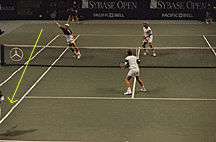<% ns_puts [mkm_getnavbar] %>
The Woodies - Volleying to the Right Place
By Monty Basnyat, TennisONE Associate Editor
For the first time ever you can learn Pro secrets of winning from coaches who train grand slam champions! With special commentary From legendary champion and Top TV analyst John McEnroe! (3 Volume Set)
If you are a doubles player, you know that a big part of the game is executing good volleys. You need pretty good hands to do well. But that's not all. Let me ask you a question regarding volleying, not on the technical side but rather on the tactics. When you approach the net in doubles where do you place your volleys? If your answer is, "Where the other guy isn't," then you need to read this lesson carefully.
The basic strategy about placing volleys in doubles is; when you have to hit a low volley (below the net), stay away from the closest opposite net player and push the ball back deep. When you get a high volley (contact is made above the net) where you are in a balanced position to execute, hit it towards the closer player and move foreword (or if you have time angle it away).
The only exception to this rule is when you get a low volley and the opposite net man starts crossing or faking, then it is important to go behind him every so often to keep him honest.
In this lesson, let's take a look at the best in the business, Mark Woodforde and Todd Woodbridge ("The Woodies" ) and analyze their volley strategy. The Woodies are on the far side of the net.


Look at the first two frames, you will notice that Todd Woodbridge (deuce) is moving
forward to volley a high ball hit by the closest opposing player. Since Woodbridge is
balanced and the approaching ball is above the net, he has two choices. Try to tag the
opposite net man, or to be kind, and angle the volley sharply to his right.

 In this frame the Woodies are in the bottom
half of the photo. The player on the far deuce side is about to execute the volley.
In this frame the Woodies are in the bottom
half of the photo. The player on the far deuce side is about to execute the volley.
Take a look at two things, the height of the ball and his footwork. The ball is high so he might want to go towards Woodbridge (in the near deuce court), but on closer inspection you can see that he is off-balanced and stretched out, which means it's unlikely that he can hit a clean, forceful volley. Volleying to the opposite net man (Woodbridge) would be very dangerous. Nine out of ten times, the player executing such a difficult, high volley, will be off-balanced and still be in the process of recovery when the opponent hits it past him. From a tactical perspective, his best option is to push this volley back deep and buy time for better positioning and better balance.
Remember, think like "The Woodies" and be tactically smart when volleying: low volley, push it back to the deep man; high volley, tag the closest person or angle it away. Again, the only exception to the low volley rule is if the opposite net man is crossing or faking (then go behind him every so often to keep him guessing). The only exception on the high volley rule is when you're off-balanced or stretched out (then vollely back to the deep man to buy time and get a better position). Good luck and always be conscious on what type of volley your about to make, low or high.
Send email to the author
We encourage you to email your comments (pro, con, appreciative, whatever) directly to
the author. To send email to Monty Basnyat, click
here.
Go To: Lessons Library
Last Updated 9/1/98. To contact us, please email to: webmaster@tennisone.com
TennisONE is a registered trademark of TennisONE and SportsWeb ONE; Copyright 1995. All rights reserved.
